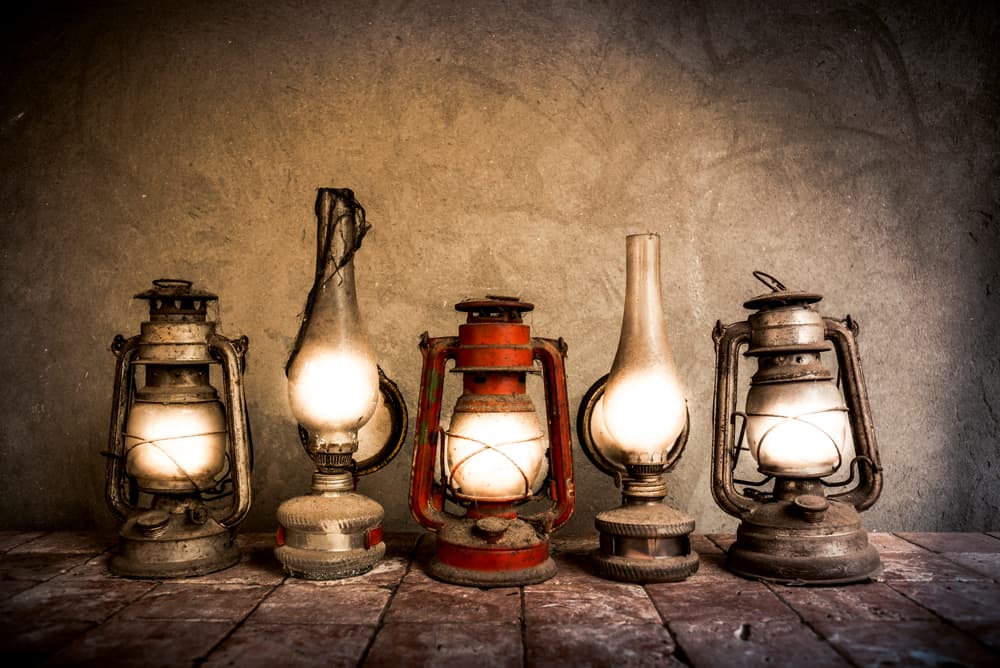You’re in possession of an old oil lamp that’s been in your family for years, and you suspect it’s valuable. Or you’d like to buy an antique oil lamp and wonder how to tell if it’s the real deal. Today, there are imitations in the market, which can create confusion. In fact, Etsy has an entire section dedicated to replicas.
So how can you tell the difference between a valuable vintage oil lamp and an imitation? Read on to learn more about antique oil lamps and how to tell if an oil lamp is antique.
Table of Contents
How Can You Tell if an Oil Lamp is Antique?
With modern lighting companies making replicas of antique lamps more and more, identifying an antique has become challenging. Here are a few tips to help you identify an antique oil lamp from an ordinary oil lamp or a replica.
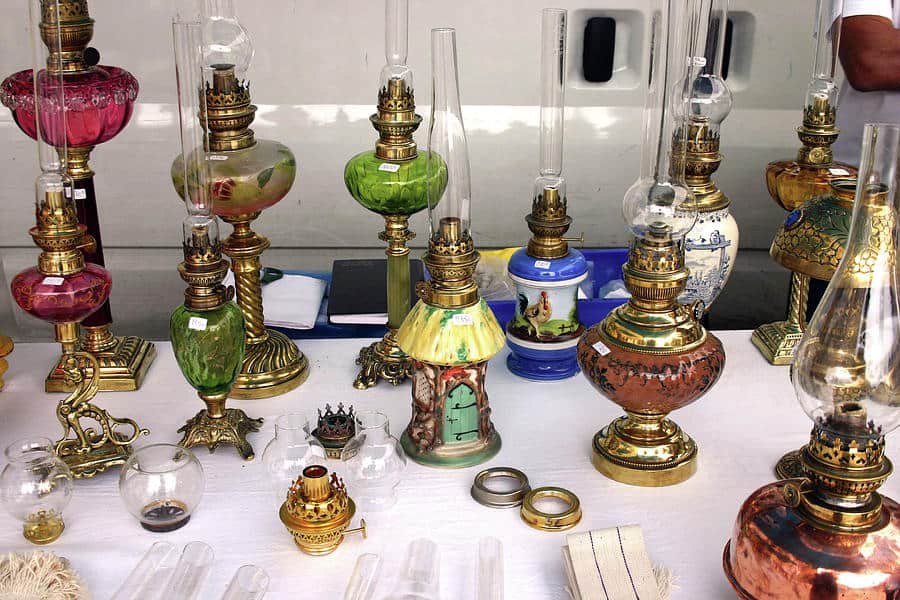
1. Check Using a Black light
One way to tell if an oil lamp is antique is to check it using a black light.
The parts of modern lamps are held together using glue and glue fluorescents with new lamps, and when exposed to a black light, they will glow.
On the other hand, an antique oil lamp has fused glass parts. The lamps don’t employ any modern techniques during manufacture. Therefore, upon exposing the lamp to a black light, the lamp won’t glow.
2. Examine the Hardware
Examining the hardware is not the most accurate method of identifying an antique lamp. Still, it’s proved to be an effective method several times.
When I say examine the hardware, I don’t mean to just look at the general structure of how the lamp was made. I mean, look at specific small key indicators.
For example, take a closer look at the bolts used on the oil lamp. Check if the screws used to hold the lamp together are shredded entirely and at the required portion.
Antique lamps often don’t have the screeds shredded the entire length, unlike their newer model counterparts.
3. Check for Plaster
Antique and modern oil lamps are almost indistinguishable when it comes to appearance. But as challenging as it can be to distinguish between an antique and a fake, you can do it with the right tips.
One great tip for identifying an antique oil lamp is to check if the lamp was made using plaster. As mentioned earlier, modern lamps, unlike antique lamps, use glue to hold parts together. However, antique lamps use plaster to hold parts in place.
Therefore, check the lamp for traces of plaster. If you find any plaster, it could indicate that the lamp is antique.
4. Check for a Manufacturer’s Identification
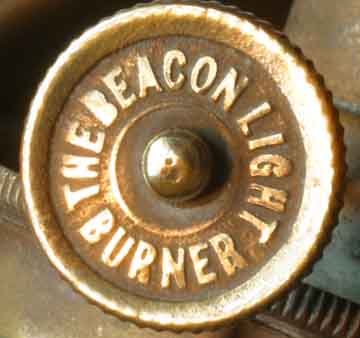
Most modern lamp manufacturers embed their company logo or initials on all their products. Therefore, examine the oil lamp for any company logos.
Designers in the past had maker’s marks. The presence of such marks signals that the oil lamp is likely antique.
Here are some of the common maker’s marks on antique oil lamps:
- Aladdin
- New Rochester Lamp Company
- Beacon Light
- Erich and Graetz
5. Check the Lamp’s Overall Condition
Another way to identify antique oil lamps is by carefully examining the lamp’s condition. Often replicas of antique oil lamps appear to be in perfect condition.
If the oil lamp appears to be in extremely good shape, it’s probably not antique. Antique lamps date back decades, even centuries back, and are likely to be knocked up.
6. Check the Accessories
Examine the lamp’s condition to see if any parts are broken, such as the bulbs, or if repairs have been made recently. Be keen to notice the material used to make certain oil lamp parts.
Most antique oil lamps are made of rare and valuable material. Therefore, if you notice that the item is mostly metal or steel, it’s probably not an antique.
What is the Value of Antique Oil Lamps?
While in the market for antique oil lamps, you’ll often hear of hefty prices. What’s worrying is that you could end up paying more for a product worth far less.
Here are a few factors to keep in mind to help you determine the value of an antique oil lamp.
1. Condition of the Accessories
If the lamp is in good condition with the parts functional, it will likely cost more. However, if you notice any broken parts or pieces, the price of the lamp should depreciate.
Similarly, if the lamp is in good condition, it’s likely to cost more. Antique lamps that have maintained their original condition demand a higher price in today’s market. A defective lamp should cost less.
Note the material used in the parts of the lamp and confirm their value.
The Accessories of antique oil lamps made of rare materials such as ivory tend to cost more than those made of ordinary material.
2. The General Look of the Lamp
Whether you’re looking to purchase your antique oil lamp at an antique store or an auction, you’ll notice that the more authentic and classic it appears, the higher the price.
Lamps made of entirely valuable materials such as gold, copper, or bronze and have unique and customary features cost more.
Also, if the lamp has any glass shades or unique colors, the cost is higher. The presence of any rare features or parts on the lamp will likely drive its price up. The same applies to if the oil lamp has any extensive decorations on the surface or an exclusive design.
3. Rarity and Historical Background
Any antique lamp deemed rare is likely to be of high value. The seller will likely increase the price of the old lamps, knowing that the chances of you getting another are next to impossible.
Similarly, older lamps with rich historical backgrounds are more valuable than ordinary oil lamps. Therefore, be keen to note the background of an antique oil lamp before purchasing.
How to Tell How Old my Antique Oil Lamp Is?
Below are some factors to consider when trying to determine the age of your antique oil lamp.
1. Antique Lamp Style
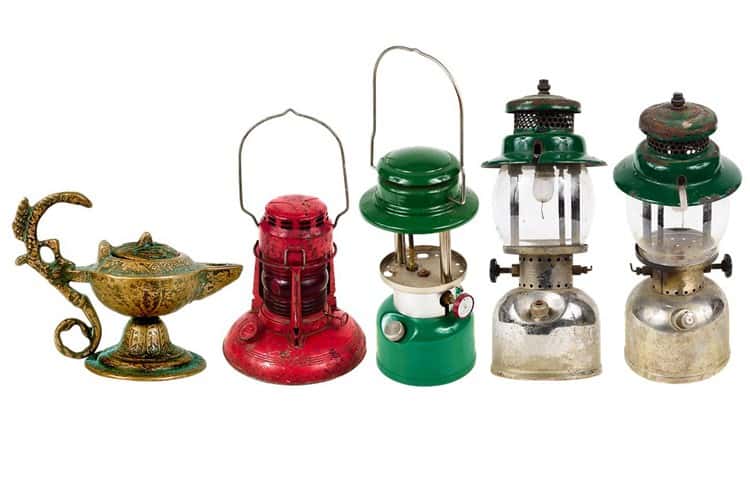
Antique oil and kerosene lamps vary in style. The style of your lamp will help determine the manufacturer and its age. Here are some of the different styles:
- Antique lamps with handles: These are lamps designed to be carried around. You’ll notice a finger loop or handle.
- Hanging antique oil lamps: Like antique lamps with handles, these have a handle that allows the lamp to be evenly placed on a nail.
- Antique kerosene table lamps: These lamps vary in size but generally have a broad base to allow them to sit upright on surfaces.
- Antique wall lamps: These lamps have a reflector that allows them to reflect light when it lies on the wall.
2. Lamp Burner Types
Identifying the type of burner your antique lamp uses can help you determine its fuel, how old the lamp may be, and other helpful clues.
Below are the different types of burners.
- Prong burners: Typically used in kerosene and oil lamps. The burners have four prongs that hold the glass chimney in place.
- Coronet burners: Also used in both kerosene and oil lamps. The burners have a crown-shaped piece of hardware that holds the chimney in place.
- Argand Burners: These burners have several holes to allow air circulation and a burning flame.
- Central draft burners: These are a lot like argand burners. They allow air circulation through the intake tube in the center.
- Whale oil burners: This burner type has two long tubes extended to the reservoir holding the wick. The tubes allow the heat from the lamp to melt the whale oil.
- Burning fluid burners: The tubes of this burner extend outward and upward from the plate. The tubes are normally made of brass.
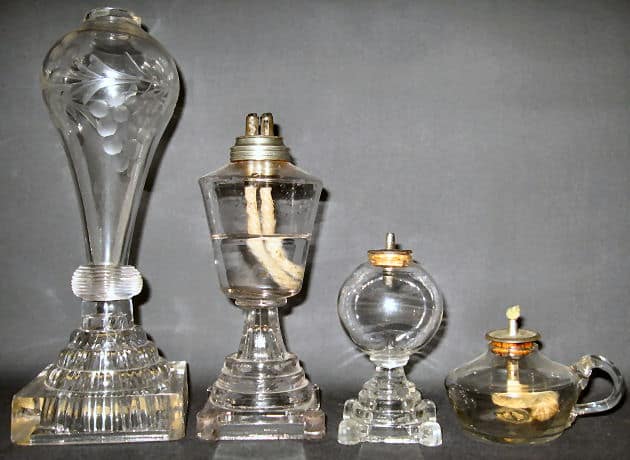
3. Antique Lamp Color
The color of a lamp is another clue to determining its age.
Most antique lamps are made of clear glass. However, there are some exceptions with beautiful colors. Most antique lamps came in clear glass or a definitive color. Therefore, if the color appears otherwise, you know it’s a replica.
Below are some of the authentic colors of an antique lamp.
- White Milk Glass
- Green Glass
- Clear Glass
- Cobalt Glass
- Red Glass
- amber Glass
Conclusion
Now you know how to identify an antique oil lamp and even tell its value by looking at its condition, how rare it is, its historical background, and its general appearance. Now you can shop with confidence. You no longer need to worry so much about paying high prices for ordinary or replica oil lamps thinking they’re vintage.
